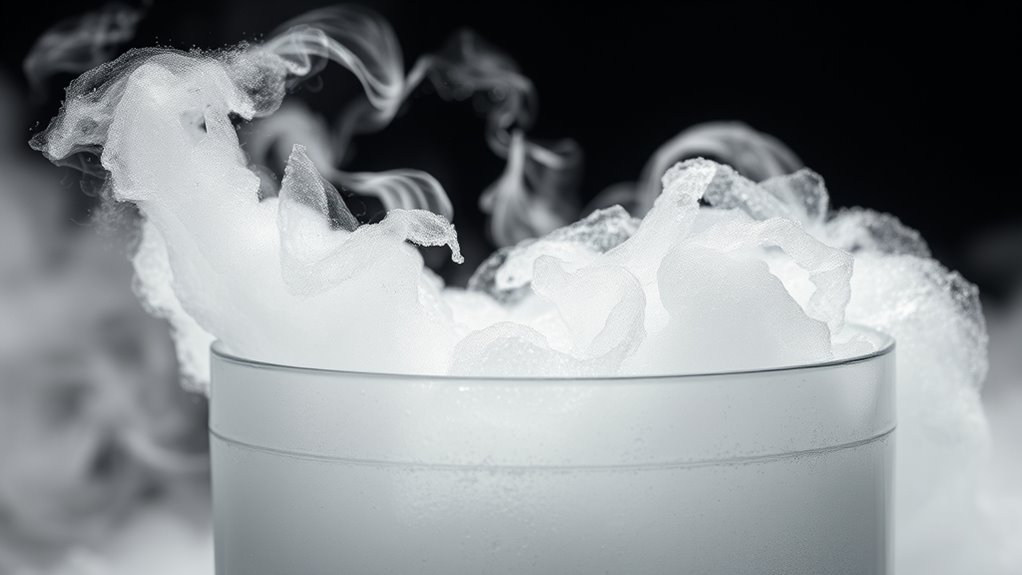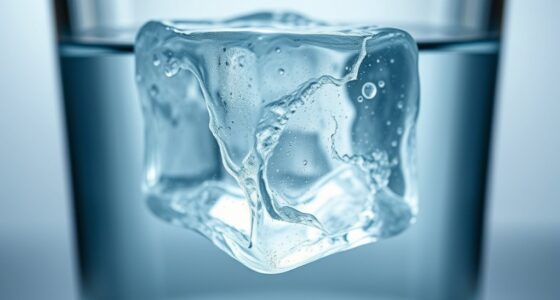Dry ice is solid carbon dioxide that sublimates, turning directly into gas at -78.5°C. You can use its rapid transformation for cool party tricks like fog effects and bubbling drinks, but safety is key—handle with gloves and guarantee good ventilation. The sublimation rate depends on factors like temperature and surface area. Want to master fun, safe ways to incorporate dry ice? Keep exploring for more tips and tricks.
Key Takeaways
- Dry ice is solid CO₂ that sublimates directly into gas at −78.5°C, creating fog effects.
- Sublimation rate depends on surface area, temperature, and environmental pressure, accelerating with higher heat or smaller pellets.
- Proper handling includes insulated gloves, ventilated storage, and avoiding contact to prevent frostbite and CO₂ buildup.
- Common party tricks involve generating fog with warm water, creating smoky drinks, and colorful visual effects with lighting.
- Educational uses include demonstrating phase changes, gas laws, and sublimation chemistry in fun, safe experiments.
What Is Dry Ice and How Is It Made?
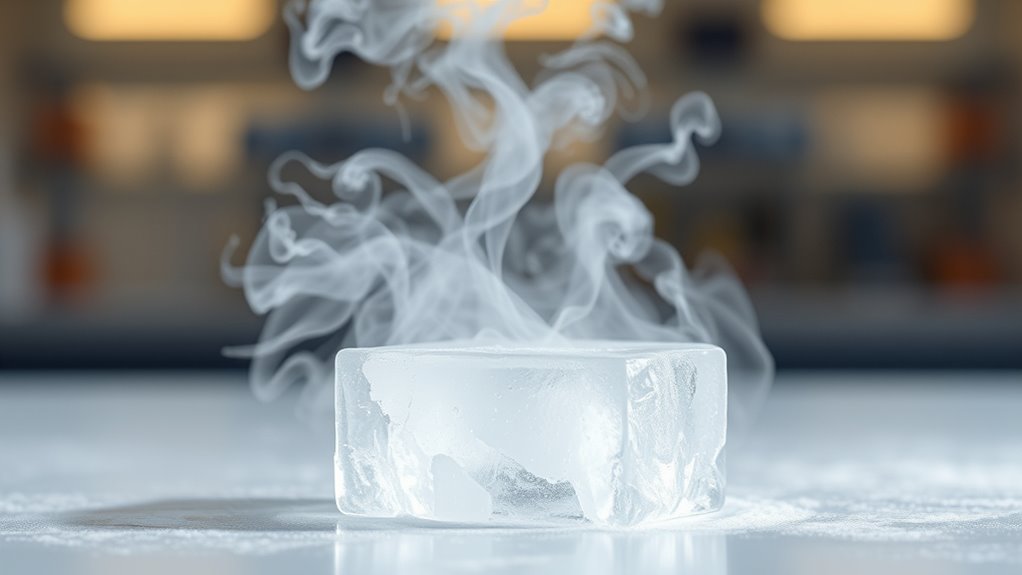
Dry ice is the solid form of carbon dioxide (CO₂), a colorless, odorless gas naturally found in Earth’s atmosphere. You should know that each CO₂ molecule consists of one carbon atom bonded to two oxygen atoms, giving it the chemical formula CO₂. In its solid state, dry ice is non-flammable, non-polar, and sublimates directly into gas at around −78.5°C, skipping the liquid phase. To produce dry ice, CO₂ gas is compressed and cooled until it liquefies. This liquid CO₂ is then rapidly expanded at atmospheric pressure, causing it to cool and form a snow-like solid. This snow is collected and compressed into blocks or pellets, ready for storage and use. The entire process guarantees the dry ice remains at extremely low temperatures, making it ideal for cooling or special effects. Understanding sublimation chemistry is essential for optimizing dry ice production and applications.
The Science Behind Sublimation of Dry Ice
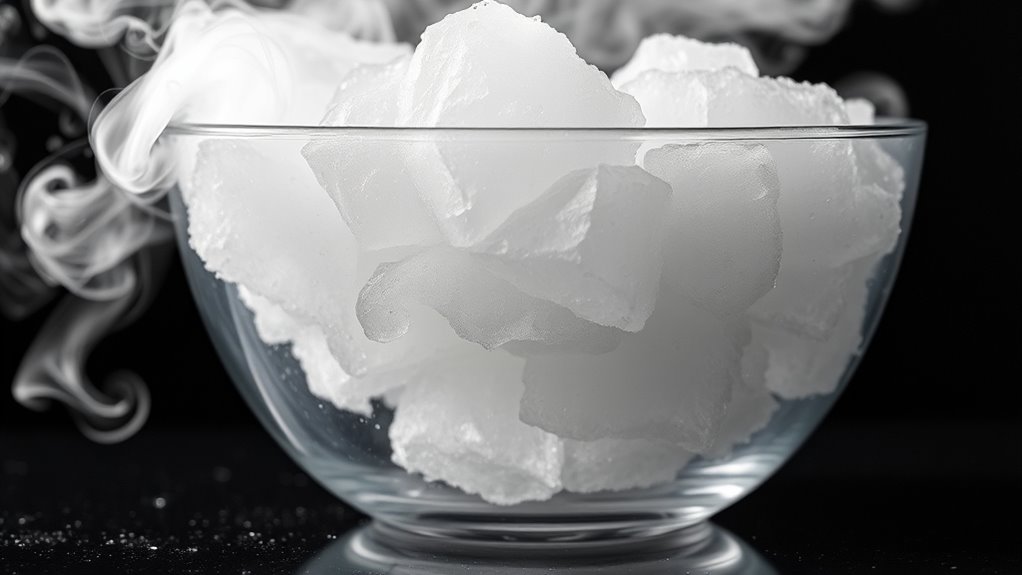
Sublimation is a fascinating process where a solid turns directly into a gas without becoming a liquid first. In the case of dry ice, which is solid CO₂, sublimation occurs at -78.5 °C under normal atmospheric pressure. During this process, dry ice absorbs heat from its surroundings, prompting the molecules to gain enough energy to escape directly into the air as carbon dioxide gas. Because dry ice can’t melt into liquid CO₂ at typical pressures, it skips the liquid phase entirely. This phase change is purely physical, with no chemical change involved. As dry ice sublimates, the gas mixes with air, creating fog or mist, especially when cooled moisture condenses. The rate of sublimation can be influenced by factors such as surface area and ambient temperature, making it a versatile tool for various visual effects and cooling applications. Understanding this process is key to harnessing dry ice’s cooling and visual effects safely and effectively. Additionally, controlling the sublimation rate is crucial for safe handling and optimal performance in special effects displays. Moreover, the sublimation process can also be utilized to create unique theatrical effects in entertainment settings, enhancing visual impact.
Factors That Affect the Sublimation Rate

Multiple factors influence how quickly dry ice sublimes, and understanding these can help you manage its behavior effectively. Ambient temperature plays a major role; higher temperatures speed up sublimation by increasing heat transfer, especially if the container lacks proper insulation. Container material and design matter too—materials with high thermal conductivity transfer heat more efficiently, accelerating sublimation. The physical form of the dry ice impacts the rate: smaller pellets or particles have more surface area and sublimate faster than large blocks. Spherical shapes minimize surface-area-to-volume ratios, slowing the process. Container dynamics, like degraded insulation in reused containers or venting mechanisms, also affect sublimation. Environmental pressure influences sublimation speed—lower pressure environments, like aircraft holds, increase the rate. Finally, frequent opening of containers introduces warm air, further speeding up sublimation. Proper storage techniques also play a vital role in controlling sublimation rates by maintaining consistent temperatures and minimizing heat transfer. Additionally, using suitable containers designed for dry ice storage can significantly reduce sublimation by providing better insulation and venting options. Understanding the sublimation process can help you optimize storage and handling to minimize waste and enhance safety.
How to Safely Handle and Store Dry Ice
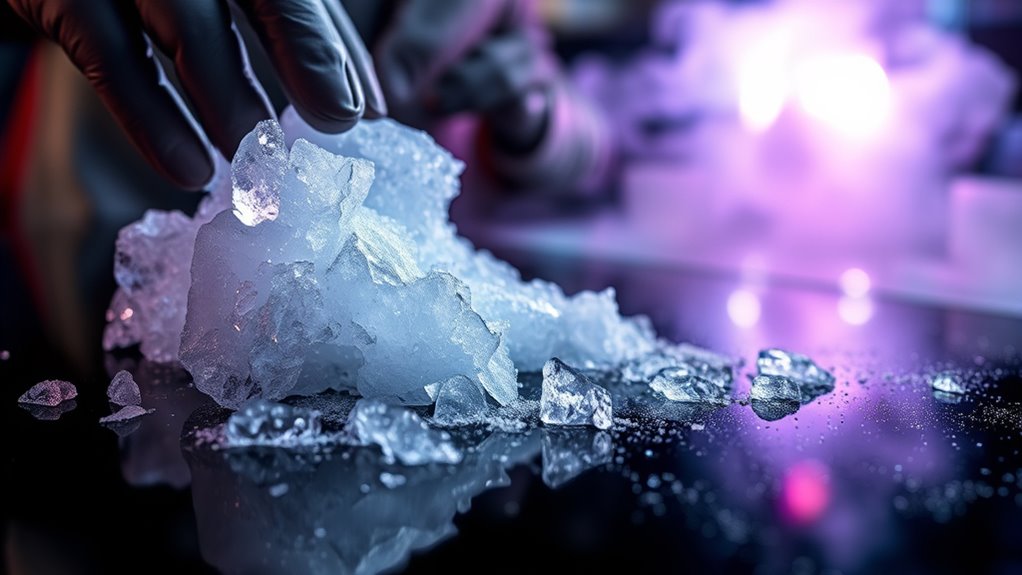
Handling and storing dry ice requires careful attention to safety guidelines to prevent injuries and hazards. Always wear insulated gloves made of leather, cloth, or nitrile exam gloves to avoid frostbite from the extreme cold. Use tongs or scoops whenever possible to minimize direct skin contact. Incorporate sound healing techniques into your safety routine, as they can promote calmness and focus during handling. Protect your eyes with goggles or a face shield, especially during cleaning or blasting. Wear protective clothing or a lab coat to shield your skin. Avoid bare hands to prevent numbness or frostbite. Store dry ice in well-ventilated areas using proper containers like Styrofoam coolers—never airtight ones. Ensure the area is ventilated to disperse CO2 gas and prevent asphyxiation. Label containers clearly, keep dry ice away from children, and avoid sealed transport containers to prevent pressure buildup or explosions.
Creative Uses of Dry Ice in Events and Celebrations
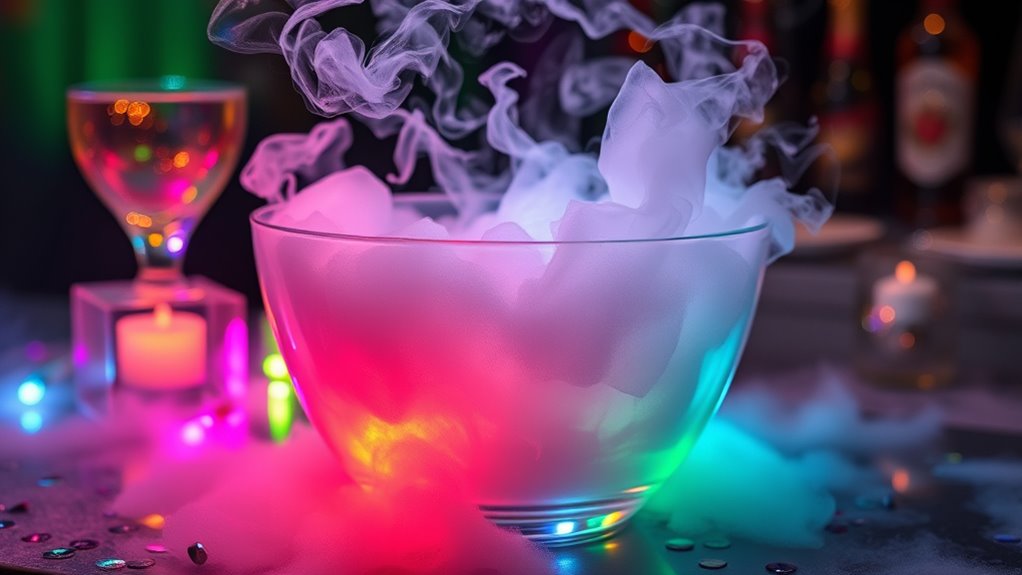
Dry ice isn’t just for safety; it can also add a wow factor to your events and celebrations. You can create foggy tables with hot water and dry ice for mesmerizing centerpieces or craft ephemeral sculptures that add an artistic touch. Leveraging AI-powered visual effects, you can design dynamic displays that synchronize with your event theme for an even more impressive presentation.
Enhance photo stations by adding fog effects, giving guests memorable photo opportunities. Combine dry ice fog with colored lights for an enchanting atmosphere or tailor effects to match themes like Halloween or futuristic parties.
Incorporate dry ice into beverages for smoky cocktails, quick-chilled drinks, foggy punch bowls, or unique dry ice pops. For special moments, use dry ice in wedding entrances, first dances, or cake presentations to create dramatic effects.
Dry ice also elevates interactive events, from volcano demonstrations to foggy mazes, making your celebration unforgettable.
Dry Ice in Scientific Demonstrations and Education
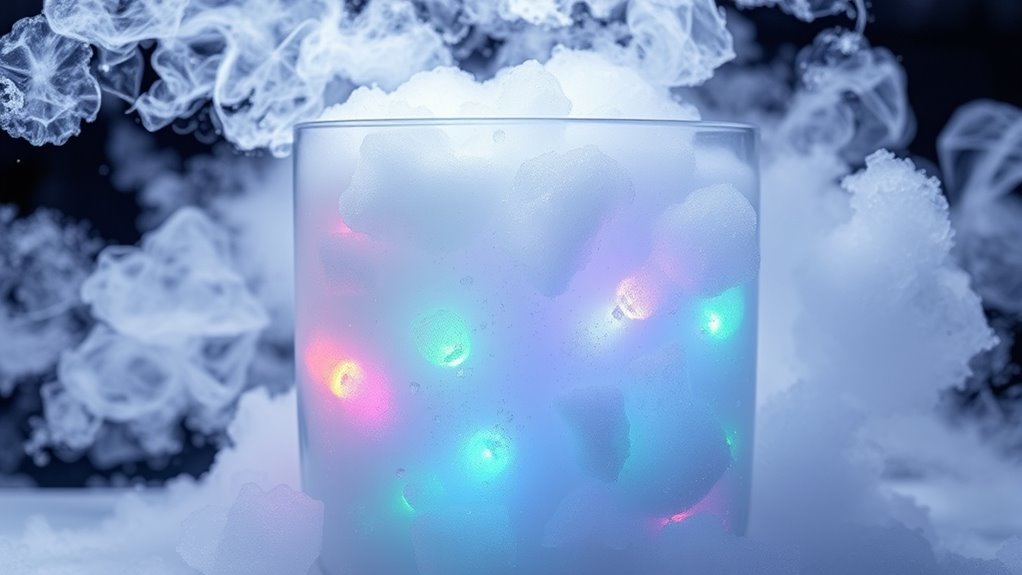
Dry ice serves as a powerful tool for scientific demonstrations and educational activities, offering vivid visual and conceptual learning experiences. You can showcase sublimation by sealing dry ice in containers, illustrating how it shifts directly from solid to gas, causing pressure buildup that can be demonstrated with rubber bungs.
The fog effect, created by atmospheric water vapor condensing with cold CO₂, captivates audiences and reinforces gas behavior concepts. You can also perform neutralization reactions by mixing dry ice with alkaline solutions and observing pH changes using different indicators like phenolphthalein, thymolphthalein, or universal pH paper.
These experiments help students understand phase changes, gas laws, and buffer systems through visual cues and hands-on engagement. Proper setup, including safety measures, guarantees safe and effective learning experiences with dry ice.
Safety Precautions for Working With Dry Ice
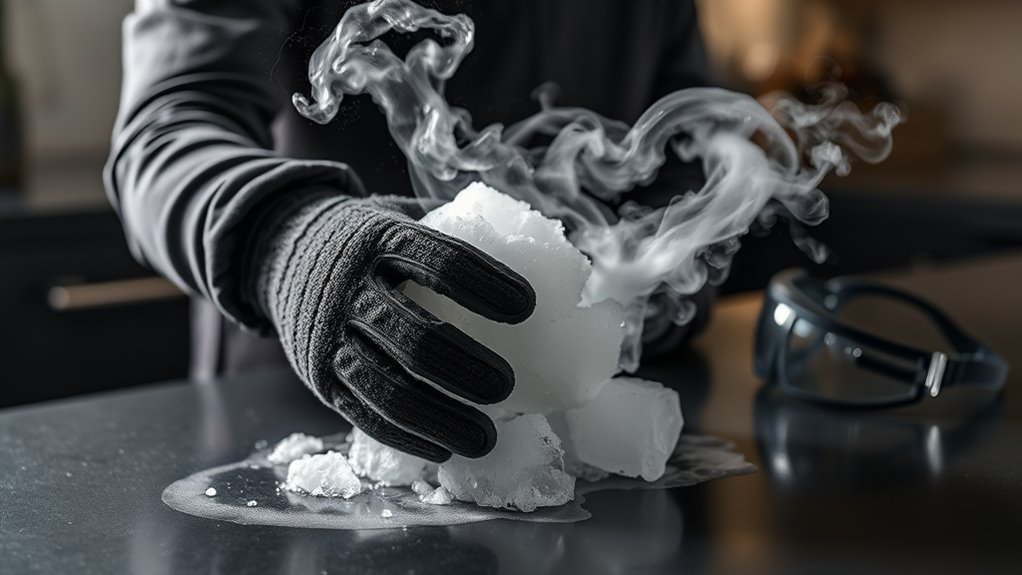
Working safely with dry ice requires strict adherence to proper precautions to prevent accidents and injuries. Always wear insulated gloves—leather or cloth—to avoid frostbite, as nitrile gloves aren’t sufficient. Use eye protection like goggles or face shields to guard against sublimation particles.
Wear closed-toe shoes and ankle-covering garments for added safety, and consider a lab coat as a barrier against splashes. Never handle dry ice bare-handed; always use tongs for transfer. Limit direct contact, even with PPE, and maintain a safe distance to prevent inhalation of CO₂.
Store dry ice in ventilated, non-airtight containers and monitor CO₂ levels in storage areas. Follow emergency procedures for frostbite, CO₂ exposure, and spills, and ensure proper ventilation during use.
Transforming Everyday Drinks With Dry Ice Effects
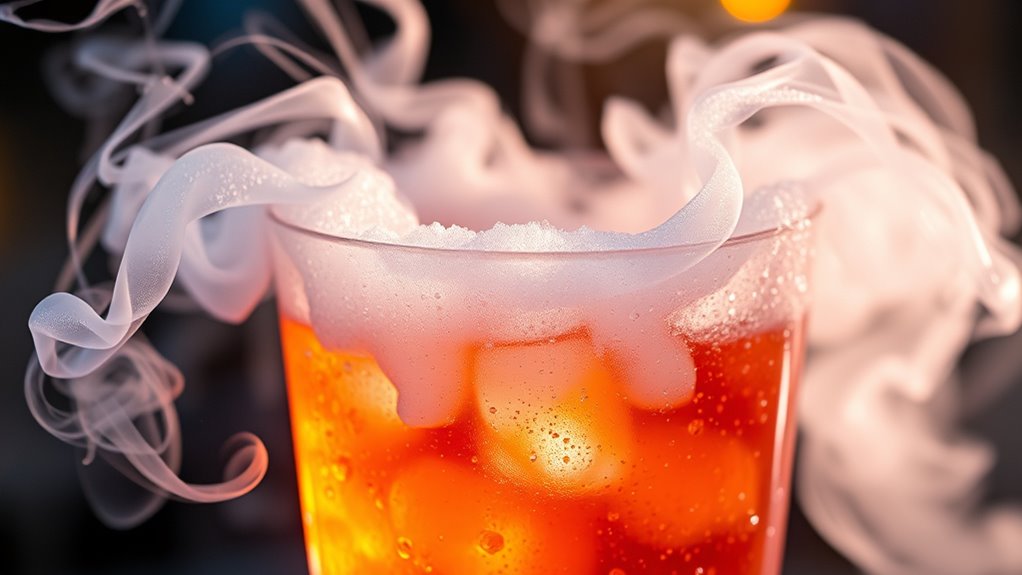
Transforming your everyday drinks into eye-catching creations is easy with the dramatic effects of dry ice. When you add small chunks or pellets to warm liquids, it creates a mesmerizing fog or smoke that flows over the glass, making your cocktails look mysterious or magical.
Add dry ice to warm drinks for a magical fog and mesmerizing presentation.
The sublimation process produces bubbling action, adding lively effervescence and visual movement. Dry ice can also flash-freeze garnishes or fruits, giving your drinks extra flair and texture.
The fog lasts about 10 minutes, then fully sublimates, leaving no residue. Since dry ice releases CO₂ gas, it can slightly carbonate beverages, creating a fizzy effect. It cools drinks rapidly, enhancing sensory experience without diluting flavors.
Just ensure the dry ice fully sublimates before drinking to stay safe.
Using Dry Ice for Medical and Transportation Needs

Using dry ice in medical and transportation applications guarantees that sensitive biological materials stay at the right temperature throughout their journey. Its ultra-low temperature of about -109.3°F keeps vaccines, blood samples, organs, and lab reagents viable during transit, even without power sources. This extended cold retention is essential for delivering COVID-19 vaccines to remote or power-insecure areas, supporting public health.
Proper packaging and handling are crucial to prevent hazards from carbon dioxide gas released during sublimation. Dry ice also serves in storage, maintaining the integrity of biological samples and pharmaceuticals without water contamination.
Additionally, it’s used in cryotherapy to treat skin conditions and in medical equipment cleaning via dry ice blasting. Ensuring ventilation and safety protocols protects personnel from frostbite and CO2 buildup during these critical applications.
Tips for Making the Most of Dry Ice Party Tricks
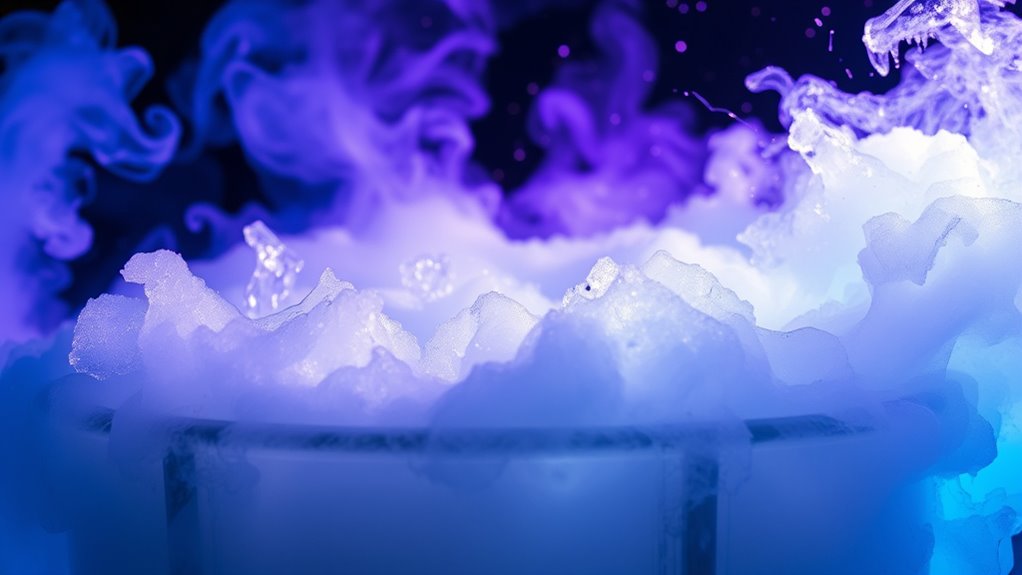
To make the most of dry ice party tricks safely and effectively, proper handling and setup are essential. Always wear insulated gloves to prevent frostbite when handling dry ice.
Keep dry ice separate from food and drinks by using different containers—dry ice in an outer container, drinks in an inner one—to avoid accidental ingestion.
Ensure your party area is well-ventilated, as sublimation releases carbon dioxide that can displace oxygen.
Keep dry ice out of reach of children and pets.
To create atmospheric fog, use hot water in a container and add dry ice every few minutes to sustain the effect. Refresh the water as needed, and layer containers for a dramatic display.
Proper safety measures guarantee fun without hazards.
Frequently Asked Questions
How Long Does Dry Ice Typically Last Before Fully Sublimating?
You’re wondering how long dry ice lasts before fully sublimating. It typically depends on storage conditions, but in a well-insulated container, it can last from several hours up to a day or more.
Factors like insulation quality, container fullness, surface area, and ambient temperature all influence sublimation speed. To extend its life, use a sturdy, ventilated container, keep it full, and minimize opening to slow down the process.
Can Dry Ice Be Reused or Recycled After Sublimation?
You might wonder if dry ice can be reused or recycled after sublimation. The answer’s no—you can’t reuse it once it turns into gas because dry ice sublimates directly from solid to vapor.
However, the CO₂ gas naturally dissipates into the atmosphere with minimal impact. To extend dry ice’s usefulness, use insulated containers and avoid unnecessary openings.
But remember, once sublimated, it’s gone for good.
What Are the Environmental Impacts of Dry Ice Disposal?
When you dispose of dry ice, you should do so responsibly to minimize environmental impacts. Sublimated CO2 contributes to greenhouse gases, so releasing it in open, ventilated areas helps prevent air pollution and suffocation hazards.
Avoid dumping it in landfills or water sources, as it can harm ecosystems. Proper disposal supports environmental health, reduces pollution, and guarantees safety for everyone around you.
Always follow safety and disposal guidelines for eco-friendly practices.
Is Dry Ice Safe for Children at Parties or Events?
Imagine you’re in a bustling 1920s speakeasy, but now, at modern kids’ parties, safety’s key. Dry ice can be safe if you follow strict precautions.
You should supervise children closely, keep dry ice out of their reach, and use it only in well-ventilated areas.
Never let kids handle dry ice directly, and always wear gloves when managing it.
When used responsibly, dry ice adds fun without risking safety.
How Does Humidity Affect the Sublimation Process?
Humidity doesn’t substantially impact the sublimation of dry ice. You won’t notice much change in how quickly it turns to vapor across different humidity levels.
Higher humidity might slightly slow sublimation in small containers, but temperature plays a bigger role.
Focus on controlling temperature and airflow, as these factors influence sublimation more than humidity.
Usually, humidity isn’t a major concern when using dry ice for cooling or fog effects.
Conclusion
Think of dry ice as your secret ingredient for turning any gathering into a spectacular show. With a little knowledge and caution, you can harness its magic to create unforgettable moments. Just like a skilled magician, you hold the power to transform ordinary events into extraordinary experiences. So go ahead—explore, experiment, and enjoy the cool wonders dry ice has to offer. After all, with a little bit of science, your parties can become legendary.
